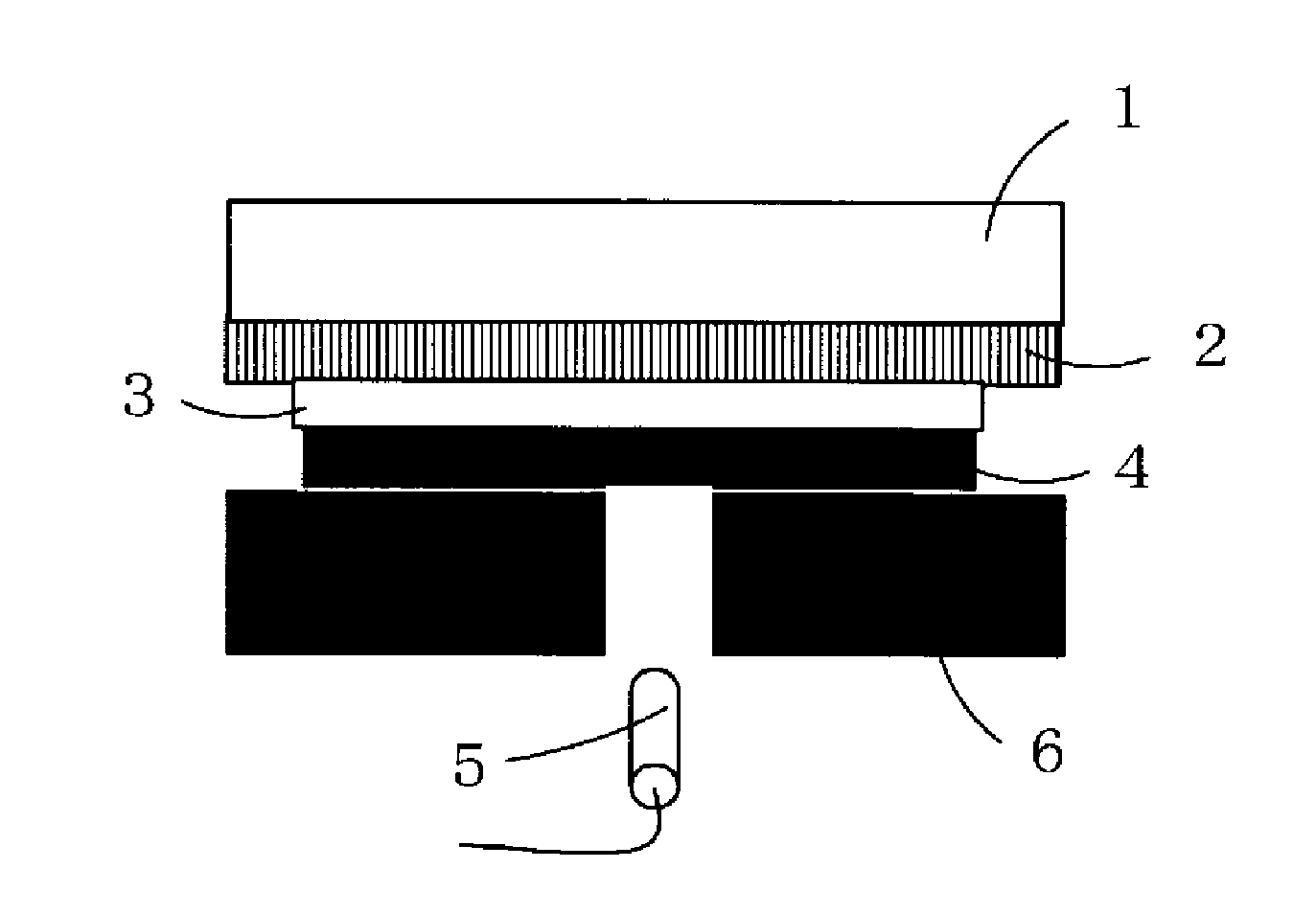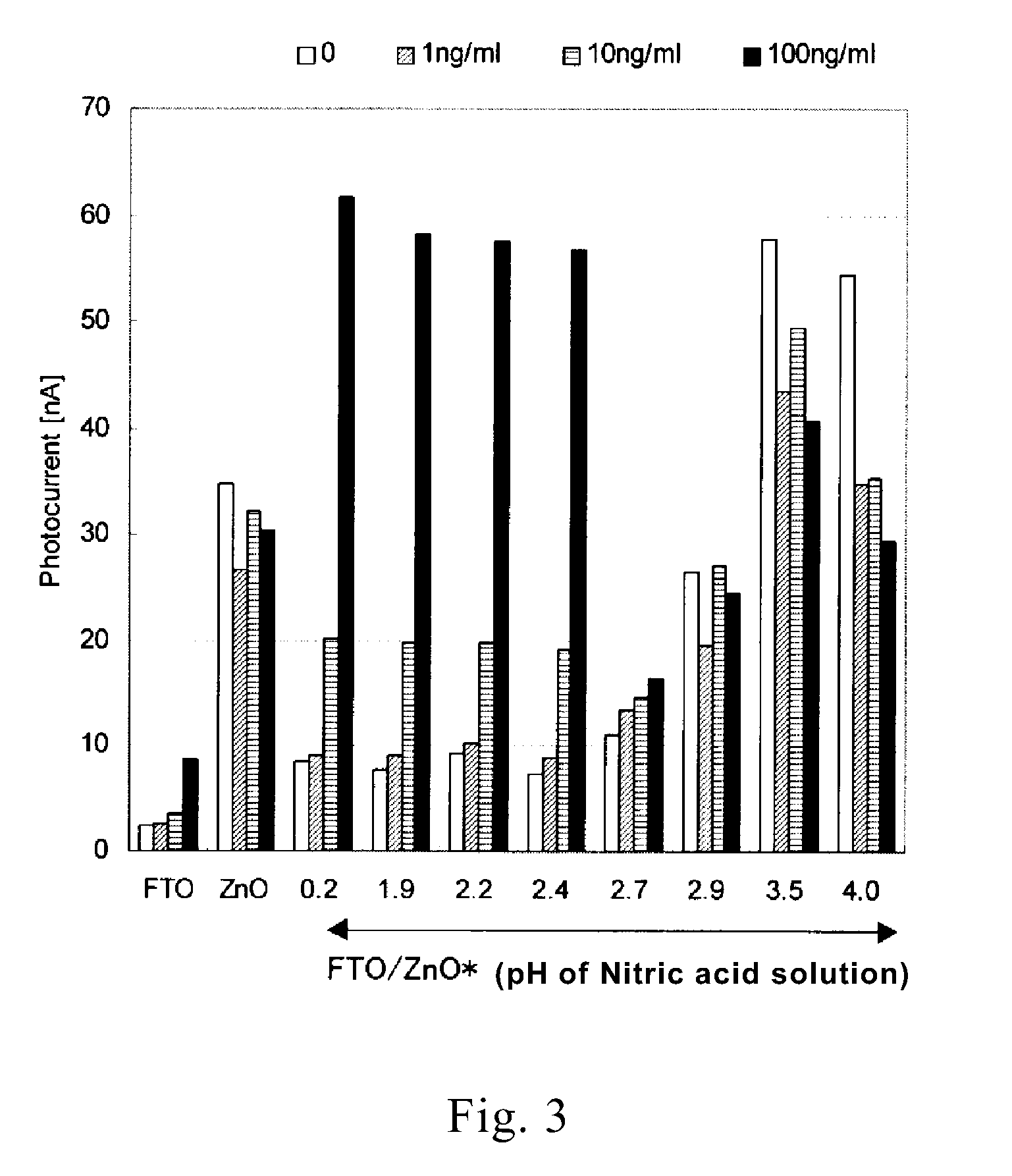Electrode member for specific detection of analyte using photocurrent
- Summary
- Abstract
- Description
- Claims
- Application Information
AI Technical Summary
Benefits of technology
Problems solved by technology
Method used
Image
Examples
example 1
Specific Detection of Protein with Photocurrent Using Different Working Electrodes
[0065]Preparation of Working Electrode
[0066]FTO Electrode
[0067]A fluorine-doped tin oxide (F—SnO2:FTO) coated glass (manufactured by AI Special Glass Company, U film, sheet resistance: 12 Ω / cm2, shape: 50 mm×26 mm) was provided as a substrate for a working electrode.
[0068]ZnO / FTO Electrode
[0069]ZnO was sputtered on the FTO electrode to a thickness of 0.44 nm (sputtering time 20 sec, 50 W, sputter rate 1.3 nm / min), to a thickness of 1.08 nm (sputtering time 50 sec, 50 W, sputter rate 1.3 nm / min), and to a thickness of 50 nm (sputtering time 8 min, 100 W, sputter rate 6.25 nm / min) to provide electrodes (film thickness: estimated roughly from sputter rate).
[0070]ZnO / FTO* Electrode
[0071]ZnO was sputtered on the FTO electrode to a thickness of 50 nm (200 W, sputtering time 8 min, sputter rate 6.25 nm / min) to provide an electrode (film thickness: estimated roughly from sputter rate). This electrode was ultra...
example 2
Partial Removal by Nitric Acid Treatment
[0079]Preparation of Electrodes
[0080]A fluorine-doped tin oxide (F—SnO2:FTO) coated glass (manufactured by AI Special Glass Company, U film, sheet resistance: 12 Ω / cm2, shape: 50 mm×26 mm) was provided as a substrate for a working electrode. Electrodes (ZnO / FTO) were prepared by sputtering ZnO to a thickness of 50 nm on the electrode in the same manner as in Example 1. The electrodes were ultrasonically cleaned with acetone, ultrapure water, and acetone successively in that order each for one min and were then immersed in respective nitric acid solutions having different concentrations. The nitric acid solutions used were prepared to have the following eight pH values (concentrations). The nitric solutions prepared and the immersion times of the electrodes are shown in Table 1. After immersion in the solutions, the electrodes were cleaned by thorough rinsing with ultrapure water.
TABLE 11pHNitric acid concentrationImmersion time0.21M3 min1.910m...
example 3
Surface Elementary Analysis of Electrode
[0085]Nine types in total of electrodes, i.e., ZnO / FTO electrodes (ZnO film thickness: 0.44 nm, 1.03 nm, 50 nm) and ZnO / FTO* electrodes (nitric acid treatment concentration: 1 M, 5 mM, 3.2 mM, 2 mM, 0.1 mM) prepared in Example 1 and the FTO electrode, were subjected to a surface elementary analysis by an X-ray photoelectric analysis. The analysis was carried out with an X-ray photoelectron spectroscopic device (manufactured by ULVAC-PHI, model PHI 1800) under conditions of X-ray source MgKα (100 W) and analysis area 0.8×2.0 mm. The results were as shown in Table 2.
[0086]It was found from Table 2 that the amount of zinc present on the surface of the electrodes varied depending upon zinc sputtering time and pH of the nitric acid solution.
TABLE 2pH ofpH of nitricnitric acidacid solutionsolutionCOZnSnFTO—23.152.70.024.2FTO / ZnO (0.44 nm, untreated)—21.452.34.222.1FTO / ZnO (1.08 nm, untreated)—23.749.510.516.3FTO / ZnO (50 nm, untreated)—26.445.927.60....
PUM
 Login to View More
Login to View More Abstract
Description
Claims
Application Information
 Login to View More
Login to View More - R&D
- Intellectual Property
- Life Sciences
- Materials
- Tech Scout
- Unparalleled Data Quality
- Higher Quality Content
- 60% Fewer Hallucinations
Browse by: Latest US Patents, China's latest patents, Technical Efficacy Thesaurus, Application Domain, Technology Topic, Popular Technical Reports.
© 2025 PatSnap. All rights reserved.Legal|Privacy policy|Modern Slavery Act Transparency Statement|Sitemap|About US| Contact US: help@patsnap.com



